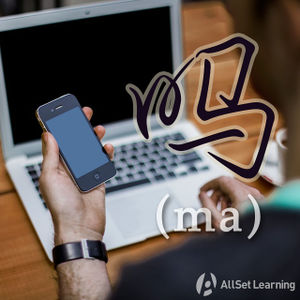Difference between revisions of "Tag questions with "ma""
| Line 41: | Line 41: | ||
== Sources and Further Reading == | == Sources and Further Reading == | ||
| − | |||
| − | |||
* [[Chinese: An Essential Grammar, Second Edition]] (pp. 144-145) [http://www.amazon.com/gp/product/0415372615/ref=as_li_ss_tl?ie=UTF8&tag=allset-20&linkCode=as2&camp=217145&creative=399369&creativeASIN=0415372615 →buy] | * [[Chinese: An Essential Grammar, Second Edition]] (pp. 144-145) [http://www.amazon.com/gp/product/0415372615/ref=as_li_ss_tl?ie=UTF8&tag=allset-20&linkCode=as2&camp=217145&creative=399369&creativeASIN=0415372615 →buy] | ||
Revision as of 09:42, 9 September 2013
-
Level
-
Similar to
-
Used for
-
Keywords
As well as yes / no questions, you can also form tag questions with 吗 (ma). Tag questions are quick questions that are tagged on the end of a sentence to ask for confirmation. In English, this is often done with "right?", or by adding the negative form of the verb phrase - e.g., "isn't it?".
The easiest way to do this in Chinese is to add an adjective and 吗 on the end of the sentence.
Basic Pattern
- ……, 好 吗? ..., all right?
- ……, 对 吗? ..., right?
- ……, 是 吗? ..., is that it?
- ……, 可以 吗? ..., is that OK?
By placing these on the end of a sentence, you can soften a suggestion or request confirmation.
Examples
- 我们 喝茶,好吗?Let's drink some tea, OK?
- 我们去咖啡店,好吗?Let's go to the cafe, OK?
- 去吃中国菜,好吗?
- 他是你哥哥,对吗?He is your older brother, right?
- 你 不 知道,对吗?
- 这样 做,对吗?
- 你 喜欢 他,是吗?You like him, right?
- 你 没有 来 过,是吗?
- 给我们十二瓶葡萄酒,可以吗?Give us twelve bottles of wine, OK?
- 妈妈,吃 两 个 冰激凌,可以吗?
See also
Sources and Further Reading
- Chinese: An Essential Grammar, Second Edition (pp. 144-145) →buy
- New Practical Chinese Reader 1 (新实用汉语课本1) (pp. 218) →buy
- Integrated Chinese: Level 1, Part 1 (3rd ed) (p. 106) →buy



